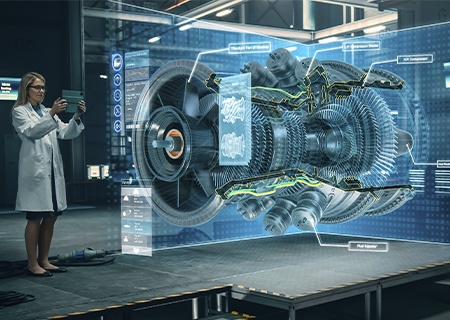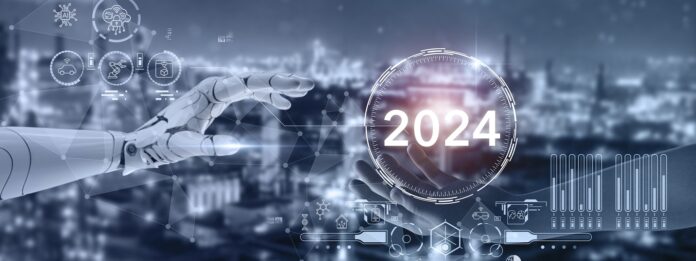The past year has brought considerable changes to the technology landscape. For many, 2023 was the year of artificial intelligence (AI) and machine learning, with platforms like ChatGPT and BardAI exploding in popularity.
It was also the year that businesses globally began to consider the long-term viability of hybrid and remote working, addressing issues of remote collaboration, productivity and cybersecurity. .
In 2023, many innovations have emerged, making forecasts for 2024 difficult in terms of technology.
Will AI continue to develop at this breakneck pace? Will immersive technologies have a lasting impact on businesses and on our daily lives? To answer these questions and more, we asked our community of experts to share their perspectives and predictions for technology in 2024.
Innovation and immersive experiences

Augmented reality (AR) and virtual reality (VR) have already seen many improvements and transformations since their introduction. Rob May predicts that these developments will continue until 2024, stating that “immersive digital experiences will be revolutionized by advances in AR/VR. They will provide more realistic interactive environments and seamless integration with real-world elements, resulting in improved education, entertainment and remote working. »
There is no denying that the integration of AI and immersive technologies will result in better immersive experiences for users. And this is thanks to the personalization potential of AI. Elena Carstoiu highlights the potential commercial applications of this phenomenon: “A study revealed that 58% of consumers consider that immersive experiences influence their purchasing decisions.
Also, it is increasingly essential to offer a personalized immersive digital experience in the sales process. Harnessing the power of AI is the only way to captivate and engage effectively.
» Consumers have increasing expectations for personalization, and immersive experiences are no longer enough to generate enthusiasm and engagement; they must also be personalized for their users.
Although immersive experiences take place in the digital space, it would be remiss to ignore the impact of innovations in the physical space.
“CPUs, RAM, GPUs, SSDs, networks and data buses have become faster, improving the user experience of AR/VR applications while graphics resolution and FPS continue to improve. to increase,” explains Geoffrey Petit .
Simon Besteman adds that Apple’s Vision Pro, announced earlier this year and scheduled for release in March 2024, is just the beginning of next-generation mixed reality (MR) headsets: “Next-generation devices like Apple’s headset aim to have a much deeper interaction with the user.
They analyze eye movement, temperature and even the electrical activity of the skin. All these additional data points not only personalize the immersive experience, but also add dimensions other than sight and sound.
Technology and hybrid work
Although much of the world has returned to working in the office, hybrid and remote work is even more prevalent than before the COVID-19 pandemic. This situation has sparked debates about the pros and cons of hybrid working, and technology is often at the heart of these discussions, both in terms of risks and opportunities.
In 2024, there may be a greater focus on personalizing and improving the employee experience for hybrid workers, creating a more inclusive and flexible work environment.
According to Frank Jennings , we can expect to see “improved collaboration and decision-making tools that will use real-time data to focus on a particular employee’s workload and strengths while ensuring their mental well-being (…) This could make employees more efficient and happier.”
Kate Sukhanova goes even further when it comes to personalization: “We will see more and more avatars (metaverse or otherwise) in the workplace, which will make it more efficient. »
Of course, AI will also play a central role in the future of hybrid work , especially when it comes to task automation. “Automation and artificial intelligence technologies will continue to develop to automate repetitive tasks and improve productivity.
They will be used to analyze data, make decisions and optimize processes,” predicts Dr Philippe Vynckier .
AI tools are already being used by businesses to automate tasks, although there are still debates about what types of work should be automated, and the impact this will have on human employees, who could see their jobs threatened.
But an even more important question arises: is hybrid working really here to stay? Simon Besteman believes that it is too early to tell, but that the long-term viability of hybrid working depends on the development and deployment of technology: “Resistance from employers and workers will have to be resolved with technical solutions.
The quality of technology will determine the future of hybrid working. » On the other hand, Mike Gillespie is more optimistic about hybrid working, but acknowledges that the quality of technology can make or break companies’ approach to hybrid working: “Current reliance on old ways of working , i.e. forcing people to go through VPN conduits to access systems, services and information, needs to be re-evaluated. »
Memory and storage
The future of emerging technologies, from augmented reality (AR) and virtual reality (VR) to the Internet of Things (IoT) , lies in innovations in memory and storage. As artificial intelligence is increasingly used across various industries and applications, its memory requirements will become an inevitable challenge for organizations that want to make the most of this powerful technology.
Elena Carstoiu explains: “AI and machine learning applications extract the information they need by processing large volumes of data (…). Storage infrastructure is crucial to ensure a continuous supply of data to these GPUs to ensure uninterrupted usage. » Also, without the necessary developments in memory solutions, the full potential of AI risks remaining untapped.
At the same time, the overall volume of data has not slowed its growth. In fact, it has continued to increase year after year, and is expected to approach * 147 zettabytes in 2024. According to Ian Moyse , memory and storage solutions will play a vital role in ensuring data is stored, used and shared : “The volume of data created is growing exponentially, as is the demand for engines to process it more quickly. Also, processing and storage needs and methods must expand to meet this demand. »
Fortunately, we are seeing many innovations and improvements in memory and storage solutions, and it is likely that they will continue for years to come. Geoffrey Petit notes that “DDR5 and SSDs are getting faster and more efficient every year, improving the overall performance of HEDTs, AI-optimized servers, and cloud servers.” Ultimately, it may be innovations in memory and storage that will drive the most exciting and significant new technologies in 2024.
The challenges of 2024

Many of the challenges that businesses and governments faced in 2023 will continue in 2024, making it important to find effective and sustainable solutions.
Supply chain issues that have emerged in recent years, caused by a number of factors including global conflict and climate change, continue to impact all industries and sectors, and the technological landscape has not been spared. Rafael Bloom notes that “global semiconductor supply problems are easing but still present.”
More generally, the effects of global inflation and economic instability will continue to affect data centers in 2024. Simon Besteman highlights the additional pressures placed on data centers by new technologies and new regulations: “Today Already, we are seeing demand for AI and machine learning solutions outpacing the capabilities of hardware manufacturers and data center hosting providers. It is not easy to combine sustainability and IT intensification. »
Cybersecurity has been one of the top concerns for businesses in 2023, especially due to the continued demand for hybrid and remote working, and this trend will certainly continue in 2024. Elena Carstoiu highlights the prevalence of cybercrime in recent years : “Studies indicate that 50% of businesses have fallen prey to a successful cyberattack in the last 3 years. The projected cost of these attacks is expected to exceed ** $1 trillion by the end of 2024.” And while technological advances, including artificial intelligence, can certainly help prevent and mitigate the impact of cybercrime , one of the biggest cyber challenges businesses will face in 2024 will be talent. “The availability of talent to address security, transformation and new technologies will continue to outstrip demand. Also, retaining the necessary talent will represent a big challenge for small and medium-sized businesses,” predicts Ian Moyse.
Trends and developments for 2024
Artificial intelligence has been mentioned numerous times throughout this article due to its significant developments in 2023, and the incredible versatility that comes with it. Rob May predicts “significant advances in AI, particularly in natural language processing, predictive analytics and ethical AI programs, which will enable more personalized and efficient services across all sectors and will make Advancing the Responsible Use of AI”, while Ian Moyse looks at AI and its role in future cybercrime: “Expect increased regulatory debate on AI and insights into AI breaches and AI risks for businesses. The increase in cyber threats and exposure reports will continue, with the first reports of the use of AI as an attack tool. »
As hardware evolution pushes the boundaries of computing, many in the technology landscape are eager to explore quantum computing. “I hope there will be some room left in the budgets to invest in quantum technology. It deserves our full attention,” says Simon Besteman. Philippe Vynckier adds that “quantum computing could revolutionize information processing thanks to calculation capacities much greater than those of traditional computers”. In 2024, quantum computing could generate the same global excitement as AI did last year.
Hybrid work will remain a hot button issue for businesses as they continue to feel the effects of the remote work boom in 2020-21. Rafael Bloom notes that “we acted so quickly due to COVID that we sometimes didn’t even question how/why an unknown risk had crept in.” While companies may have new technologies and tools to implement hybrid teams, they may also discover new pitfalls and risks that they will have to face.
Finally, it will be impossible to ignore talent issues in 2024, says Elena Carstoiu: “According to a Gartner survey, 26% of CEOs cited talent shortage as the biggest risk for their company *** .
Prioritizing talent attraction and retention, as well as improving workforce productivity, is essential. » And while various AI technologies can mitigate the impact of a talent shortage through task automation, businesses will definitely need to focus on attracting skilled people who will be able to fight cybercrime, to manage data and deal with all the other future challenges they will face in 2024.
At Kingston Technology, we see ourselves as trusted advisors, always on the lookout for emerging technology challenges and opportunities, from AI innovations to new cybercrime risks. While we know that businesses will face both new and old problems in 2024, we are confident that our expertise and solutions will help our clients cope with this ever-changing world.



